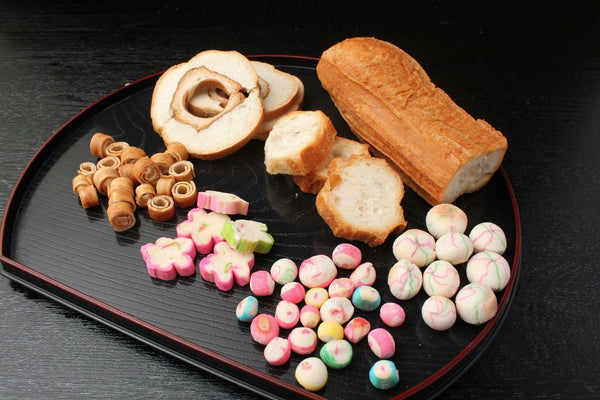
Jump to:
Many vegans and vegetarians are probably already familiar with “seitan” as a meat substitute. Seitan is wheat gluten that has been kneaded in such a way that the gluten strands are formed into the shape of meat. However, for centuries before the popularity of the macrobiotic diet in Western countries, Japanese people have been eating something called Fu, as a non-animal protein source. This is also made from the gluten extracted from wheat flour and is sometimes eaten in combination with other ingredients.
In this blog post, we shall look at the two main types of Fu, its taste and texture, and its history and culture, focusing particularly on its links to Buddhism. We shall also discuss the various forms it takes, its health benefits, and how it is used in cooking. We shall then round off with a discussion of Miyamura, a leading Fu brand in Japan.
What Are The Main Types Of Fu?

The two main types of Fu are Nama-fu (fresh Fu) and Yaki-fu (baked Fu). Before looking at these in turn, however, it may be instructive to do a quick recap on what gluten actually is. When wheat flour is mixed with water, a rubbery, creamy mass (responsible for the fluffiness of bread) is formed. This is the protein element of wheat. While naturally occurring, gluten can also be added to foods and used as a binding agent. Nama-fu is a gluten-based processed food that is made by adding glutinous rice flour to the gluten and then steaming or boiling it. Nama-fu is characterized by its firm gluten-derived texture and elegant non-distinct taste.
Due to its much longer shelf life and ease of transportation, however, people living outside of Japan are much more likely to be familiar with Yaki-fu. Yaki-fu is also made by kneading gluten, which, after adding wheat flour to the gluten, as well as starch and a buffering agent, may be mixed with other ingredients and baked into a particular shape. This makes an excellent non-perishable food, making it extremely useful for emergency supplies in countries prone to earthquakes, like Japan.
Taste & Texture Of Fu

Even staunch advocates of Fu would probably agree that as a food on its own, it is fairly tasteless. Both its taste and texture, when dry, resemble dried bread (which, minus a few ingredients, such as yeast, it essentially is). Fortunately, in most situations, you will not be expected to eat it on its own. Its sponge-like qualities mean that it absorbs the flavors of the ingredients it is cooked with. When reconstituted, or in the case of Nama-fu, it tends to have a soft and fluffy, or sometimes silky, texture.
Where Did Fu Come From?
Like so many foods now considered quintessentially Japanese, Fu was introduced to Japan by China. In the Muromachi era (1336-1573), ascetic monks traveled to China where they came across something referred to locally as “menchien”. Translated literally as “wheat muscle”, this referred to the wheat protein created by kneading “ground wheat” and washing it to separate the starch from the protein.
At that time, Zen monks were strictly forbidden to eat meat, and Fu was thus highly prized as a top-quality dietary protein to rival tofu and yuba. Its role in food was nurtured in the temples, becoming a prominent part of Shojin Ryori, which is traditional Buddhist cuisine. In the early days, wheat was scarce, so Fu was only consumed at court or on special occasions. However, in the Edo period, in addition to its inclusion in Kaiseki-ryori, the Sado tea ceremony, and as part of Buddhist memorial services, it enjoyed more mainstream consumption by the townspeople as well.
With the further development of industry in the Meiji era, it was possible to use much finer ground flour, and the gluten produced from this had an unprecedentedly smooth texture that could be crafted into the exquisite shapes and forms seen, for example, in “Kyo-fu”, or Kyoto-style Fu. It was also in the Meiji era, that Yaki-fu became a favorite addition to Sukiyaki (beef hot pot).
Various Forms of Fu
Within the two basic categories of Nama-fu and Yaki-fu, there is a wide variety of types to choose from and try. Each has its own distinctive texture, and the creative way that their devotees have added color and designed their shapes stimulates both the appetite and the mind. Although far from an exhaustive list, we shall introduce you to some of those types below.
Types of Nama-fu
Yomogi-Fu

This bright green fu, created by kneading yomogi(mugwort) into the Fu, allows you to enjoy both the light texture of the Fu and the delightful aroma and flavor of mugwort. Sesame is also sometimes used as a variation on this theme.
Sudare-Fu

This hails from the Kaga region of Ishikawa Prefecture. Similar in appearance to Yuba bean curd, Fu stretched out on a roll is steamed and dried in the sun. It is one of the essential ingredients in Jibuni, a local Kaga specialty dish consisting of duck, sudare-fu, and vegetables.
Temari-Fu

This is a type of Fu often used to add an accent to Chawanmushi and O-suimono (clear soup). It is fair to say that this type of Fu is more about aesthetics than taste, as small, rounded pieces of Fu are decorated with vibrant colors and exquisite patterns.
Types of Yaki-fu
Kuruma-Fu

“Kuruma” means car or wheel in Japanese and, as the name suggests, Fu is wound around a stick and baked over an open flame into the shape of small wheels.
Shonai-Fu

Shonai-Fu, also baked over an open flame, is sometimes referred to as Ita-Fu (literally “board Fu”). After baking, the dough is cooked into flat sheets. Although there was originally a practical reason for its design, in that it would take up less space when loaded into ships, this has become a specialty item in the Yamagata Prefecture area
In addition to the two varieties cooked over an open flame described above, there are several varieties that are baked in a pot, including Shiratama-Fu, Takebayshi-Fu, and Komachi-Fu.
What Are The Health Benefits Of Fu?
As discussed previously, a major factor in its introduction to Japanese cuisine was the recognition of it as a high-quality protein source that could complement Buddhist cuisine, where the eating of animal protein was eschewed. So, what are the health benefits of Fu? Firstly, it is extremely low in fat and high in protein. In 100g of dried Fu, there are a whopping 28 grams of protein and only 369 calories.
Fu contains high levels of calcium, as well as glutamic acid, a neurotransmitter that is effective in developing and activating the brain. It helps bring about beautiful skin, and, by providing necessary nutritional elements with a reduced calorie intake, is also effective in aiding weight loss, and preventing hyperlipidemia, diabetes, obesity, and hypercholesterolemia.
Fu is both vegetarian and vegan friendly and can be an effective weight control tool for everyone except those with gluten intolerance, who should obviously steer clear.
How is Fu Used in Cooking?

As Fu has very little taste on its own and absorbs the tastes of the things it is cooked with, it is ideal as a quick protein source where you don’t want the original flavor or color of the food to be overwhelmed or intruded upon. This makes it very popular in delicately flavored clear soups, as well as chunkier miso soups (for an example of how Fu is used in miso soup, check out the Nagatanien instant miso soup on our website). It is also used in various nabe dishes, such as sukiyaki, and in fried dishes as part of Okinawan cuisine.
In addition to its use in cooking, the ease with which the gluten can be flavored and colored has led to a wide range of confectionery uses for Fu, as well. These include Fu-manju, in which Nama-fu is filled with anko red bean paste, the highly colorful Fu-gashi, and Fu-Karinto, in which the dough is sweetened with brown sugar, reminiscent of the deep-fried bread of the same name.
The Best Japanese Fu Brand

Miyamura Seifu Inc. has been creating Fu-based products ever since its founder, Goroshichi Miyamura completed his training and started manufacturing Fu in Shibata City in Niigata in 1902. Their goals as a company are to spread Fu around the world, so that it can be enjoyed by an ever-increasing number of people, and to continue to strive to produce the most delicious Fu using the best ingredients in its wide range of Nama-fu and Yaki-fu products.
The Japanese Taste website features dried Miyamura products in a wide variety of forms that you can include in your cooking, as well gluten flour for the truly adventurous who would like to try making Fu from scratch. You can find our range of Miyamura products here.
Fu – More Than Just A Simple & Easy High Protein Source
As we have discussed, Fu is a type of food that was originally adopted in Japan to provide a source of high-quality non-animal protein, and due to its strong nutritional profile, is still used as a quick and simple way of adding protein to dishes such as soups in a way that does not overwhelm the taste or appearance of the dish in question.
As it absorbs the tastes of the surrounding ingredients, it has also developed into a means of allowing food artisans to express themselves aesthetically with a wide range of different colors and designs, and subtle flavors.
What is your favorite way of eating Fu? Let us know in the comments.


0 comments